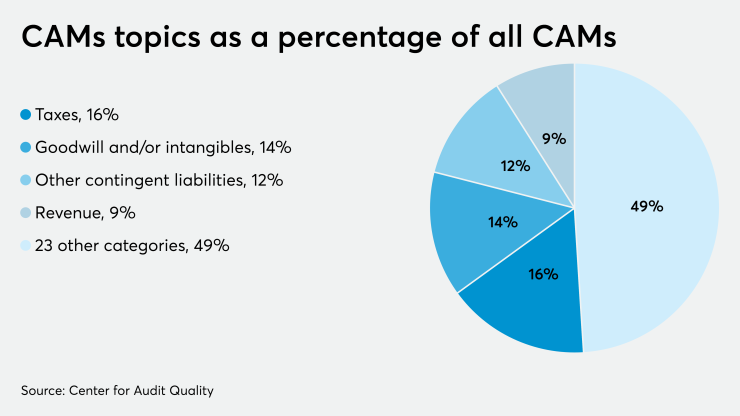Companies discussed taxes, followed by goodwill and/or intangibles, most frequently during their first year of disclosures of critical audit matters, according to a new report from the Center for Audit Quality.
The Public Company Accounting Oversight Board defines a CAM as any matter arising from the audit of the financial statements that’s communicated or required to be communicated to the audit committee relating to accounts or disclosures that are material to the financial statements and involved especially challenging, subjective or complex auditor judgement.
The board began requiring the largest public companies to include a discussion of critical audit matters, or CAMS, in their audit reports last year. Auditors began communicating CAMs in their auditor’s reports of large accelerated filers in 2019. The phased implementation approach based on filing status means that a year from now thousands more disclosures of CAMs will be included in auditor reports.
The CAQ report,

Of the 198 CAMs identified within auditor’s reports in the S&P 100, taxes made up 32 CAMs, goodwill and/or intangibles comprised 28 CAMs, contingent liabilities accounted for 23, and revenue 18.
The report noted that it’s not surprising that matters in the four main categories would meet the definition of a CAM. “Accounts and disclosures in these four areas are typically material to the financial statements, are matters that would be communicated or required to be communicated to the audit committee, and are matters that often involve a high degree of management judgment, which could in turn involve especially challenging, subjective, or complex auditor judgment,” said the report.
The CAQ also found that every auditor report for S&P 100 companies included at least one CAM disclosure. Auditor reports included a total of 198 CAMs, which is an average of a little less than two (1.98) CAMs per report. One auditor report communicated five CAMs, while 32 auditor reports communicated only one CAM.
“Public company auditors have embraced the PCAOB’s requirement to report critical audit matters, initiating a new era of increased transparency around the audit,” said CAQ executive director Julie Bell Lindsay. “We want investors to know that critical audit matters add to the total mix of information available as they make capital allocation decisions. The requirement for the auditor to determine and communicate critical audit matters is one of the most significant changes to the auditor report in decades. The audit profession’s extensive up-front planning resulted in disclosures that give investors a better understanding of the areas of the audit that involved especially challenging, subjective or complex auditor judgment.”




